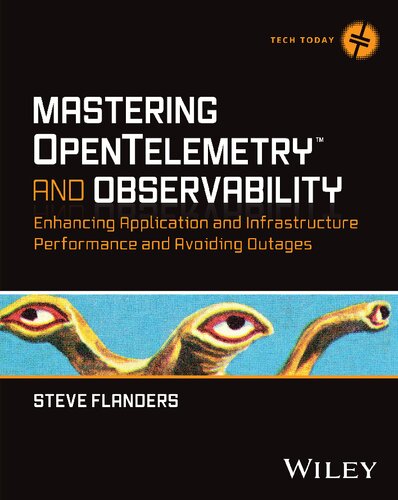Insights from Mastering OpenTelemetry and Observability
In the fast-paced era of cloud-native systems and distributed architectures, maintaining visibility and reliability across complex infrastructures has become crucial. This led me to explore Mastering OpenTelemetry and Observability by Steve Flanders. The book is a deep dive into the tools, techniques, and methodologies for achieving robust observability using OpenTelemetry, a leading open-source framework.
Written by a key contributor to OpenTelemetry, this book offers both technical expertise and actionable strategies for leveraging observability to improve system performance and reduce outages. It’s a must-read for anyone looking to enhance their understanding of telemetry data and system diagnostics.

Summary
Chapter 1: What Is Observability?
This introductory chapter defines observability and explains its significance in the cloud-native era. It contrasts observability with traditional monitoring, emphasizing that while monitoring handles predefined scenarios, observability helps tackle the unknown. Key concepts like dimensionality, cardinality, and semantic conventions are introduced, highlighting their roles in telemetry data analysis.
Quote: "Observability is about making systems understandable through the data they emit." – Steve Flanders (Page 5)
Chapter 2: Introducing OpenTelemetry!
The chapter discusses the evolution of open-source observability tools and introduces OpenTelemetry as a unified standard. It explains how OpenTelemetry simplifies data collection through its components: APIs, SDKs, and collectors. Readers also get a glimpse of the roadmap for OpenTelemetry's continued development.
Chapter 3: Getting Started with the Astronomy Shop
Here, the book takes a hands-on approach, walking readers through setting up a sample application (the Astronomy Shop) for exploring OpenTelemetry's capabilities. It covers architecture design, telemetry data access, and advanced configurations like load generation and feature flags.
Chapter 4: Understanding the OpenTelemetry Specification
This chapter delves into the technical specifications of OpenTelemetry, including its APIs, SDKs, and data models. It also emphasizes semantic conventions and compatibility considerations, providing a solid foundation for developers looking to contribute to or adopt OpenTelemetry.
Chapter 5: Managing the OpenTelemetry Collector
The focus here is on the OpenTelemetry Collector, a critical component for processing and exporting telemetry data. It discusses deployment modes, reference architectures, and configuration details, offering practical guidance for managing complex telemetry pipelines.
Chapter 6: Leveraging OpenTelemetry Instrumentation
This chapter offers practical guidance on setting up OpenTelemetry for Python applications. It covers automatic, manual, and programmatic instrumentation techniques, demonstrating how to capture comprehensive telemetry data.
Chapter 7: Scaling Observability
Scaling observability for large systems is addressed here, with discussions on managing high-cardinality data and ensuring performance. The chapter highlights strategies for scaling OpenTelemetry deployments in dynamic environments.
Chapter 8: Observability in Distributed Systems
The focus shifts to challenges specific to distributed systems, such as ensuring traceability across services. The chapter discusses OpenTelemetry’s role in addressing these challenges through distributed tracing and contextual propagation.
Chapter 9: Advanced Instrumentation Techniques
This chapter dives into advanced techniques for customizing telemetry data, such as enhancing traces with metadata and dynamically configuring instrumentation.
Chapter 10: Troubleshooting with Observability
The chapter provides strategies for diagnosing and resolving system issues using observability tools. Case studies demonstrate how OpenTelemetry data can uncover root causes of performance bottlenecks and failures.
Chapter 11: Observability in Practice
Here, the author shares real-world examples of implementing observability in various industries. Readers gain insights into tailoring observability practices to meet specific organizational needs.
Chapter 12: The Future of Observability
The final chapter explores emerging trends in observability, such as AI-driven insights and automation. It also discusses how OpenTelemetry is poised to evolve as the standard for telemetry data collection.
Key Takeaways
Key Takeaway 1: Observability Is Critical for Modern Systems
- Observability enables diagnosing unknown issues, setting it apart from traditional monitoring.
- This takeaway reinforces my belief in proactive system management as a cornerstone of effective engineering.
Key Takeaway 2: OpenTelemetry Standardizes Observability
- OpenTelemetry consolidates observability practices into a unified framework, reducing complexity.
Key Takeaway 3: Scaling Requires Strategic Planning
- Successful observability in large systems depends on managing cardinality, optimizing performance, and using semantic conventions.
- This takeaway resonates with my experience in platform engineering and large scale operations, where scaling observability often determines success.
Key Takeaway 4: Collaboration Improves Outcomes
- Semantic conventions and shared tooling foster better collaboration among engineering teams.
Key Takeaway 5: The Collector Is the Backbone
- The OpenTelemetry Collector acts as a versatile middleman for telemetry data, ensuring reliable ingestion and export.
- This component reminds me of the importance of robust intermediaries in any system architecture.
Personal Reflections
This book has reshaped how I approach observability, emphasizing its role as a tool for both system reliability and collaboration. It has inspired me to incorporate OpenTelemetry into my projects and to explore advanced instrumentation techniques. The focus on community and open standards aligns with my passion for contributing to open-source initiatives.
Conclusion
Mastering OpenTelemetry and Observability is a definitive guide for anyone involved in modern system management. Steve Flanders combines technical expertise with actionable insights, making this book essential for engineers, architects, and managers. Whether you're new to observability or seeking to refine your practices, this book is an invaluable resource.